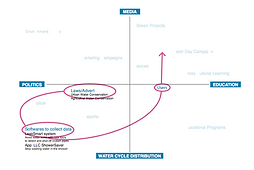
Portfolio
Isaac

CULTURE OF WATER USAGE IN SAVANNAH
DESIGN RESEARCH
In Contextual Methods of Research, we developed the theme of “the culture of water usage in Savannah” through applied ethnography including secondary research, primary research, from our research ndings we a nitized, came up with insights for this theme, practiced design thinking and elaborated preliminary concepts.
Secondary Research

Mind Map
We first built a mindmap. We consider a warmup for our creative process so we used nouns to create this net work of common knowledge. Out findings of this activity leads us to a central theme: PEOPLE. From the begining, we knew that we would focus our research in a human-centred way.



Data Research
After researching experts ndings about water and water usage worldwide, we built a war wall with all our research so that we could visualize better the data.
Modes Finding
We used the book “101 Design Methods” from Vijay Kumar as the base for our modes. We chose 5 methods within his chapters 1(sense intent) and 2(known context) .

Fields Chart
We also discovered from our mindmap three main fields represented by organic that is environment, location and history, human as people, need, habits, education and media also business having industries and organizations.

AEIOU
We chose to do the AEIOU analysis because this framework allows us to visualize the system as a hole and in our case, water is all about the connection between activities, environment, interaction, objects and users.

10 Types of Innovation Framework
For this mode we were able to nd the opportunity gap in the water usage system, the scale from none to overuse of water activity provided us with some initial insights that helped understand where the gap was and what we could do about it.





Initial Opportunity Map
We used the Initial Opportunity Map to better understand how the “players”of water usage relate and how is the communication flow relevant to a new possible approach or opportunity to redesign the water system.
This is the framework structure. The three different colors represent three different situation flows that were found when we developed this mode.
Convergence Map
Insight 1
Increase of environmental awareness, individuals and corporations are attempting to engage more sustainable behaviors.
Insight 2
Transnational water trade
has developed to balance the irregular distribution of water resources all over the world.
Insight 3
Information technologies has improved the water services.


Insight 4
Water demands keeps growing all over the world reuse, recycle and appropriate disposal have been on “focus” these last few years.
Insight 5
Reuse, recycle and appropriate disposal have been on “radar”.
Insight 6
Water demands keeps growing all over the world
Primary Research
Field Observation







Observation Boards
Putting together the photos and making notes on post-its a er the observation series

Interviews


2 x 2
We created a 2 x 2 model based on the interviews. Ths helped us to better understand how people think towards different directions

Affinity Diagram
After collecting all the data from the interviews, we used all points to build multipule clusters. Within those clusters we developed other sub-clusters, in order to hep us use design thinking method and create our final insights.
Below photos from the affinity sessions.

Interview Insights


Drivers Mode
Our driver statement is a question because we realized that our subject is a big question mark so we can’t make a a rmitive about it. We choose “What is the value of water to me?” with the complementary sentences. Also our subject was found in a negative way as in people don’t feel the need to value water.

Main Insights


How might we?




Priliminary Concepts
Concepts
Our priliminary concepts comes from our research insights


Final Presentation


